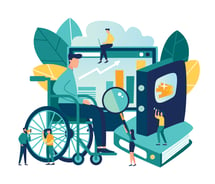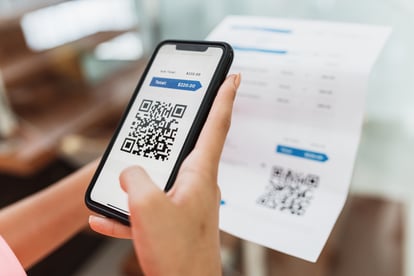Printers often focus on how a project looks. Are the colors right?  Is the registration exact? Any smears or smudges? Are the graphics and text sharp and clear? These are all important, of course, but we usually base the analysis on what we can see, hold, and touch. How often do you consider the suitability of a printed piece for someone with a disability? Nearly a quarter of the global population is disabled, and regulations like the Americans with Disabilities Act (ADA) make looking at a piece from an accessibility aspect important.
Is the registration exact? Any smears or smudges? Are the graphics and text sharp and clear? These are all important, of course, but we usually base the analysis on what we can see, hold, and touch. How often do you consider the suitability of a printed piece for someone with a disability? Nearly a quarter of the global population is disabled, and regulations like the Americans with Disabilities Act (ADA) make looking at a piece from an accessibility aspect important.
When you think of disabilities, you might be considering only impairments we can see. These are obvious to us. Not so noticeable are difficulties with thinking, memory, learning, or communicating. Designers and printers must also consider them as conditions that affect an individual’s ability to read and understand a printed piece.
Accessible design doesn’t have to limit creativity. It’s all about making adjustments so the printed or electronic piece can connect with the entire audience.
Web pages are an area where design decisions can make it difficult for a disabled person. Pay attention to how you lay out the screen. It makes a difference for aids such as screen readers. Navigational tools should be easy to use and keyboard functions should be available, when possible, not just mouse clicks.
People with seizure disorders are sensitive to blinking and flashing elements. Designs that feature elements with over three flashes per second might trigger a seizure. Parallax scrolling gives the viewer the illusion of depth by causing background images to move at different speeds than the foreground, but can be troublesome for viewers with motion disorders.
Color
A common accessibility mistake is to make color the only way to convey information. This presents problems for color-blind people who cannot distinguish between different shades. Soft yellow text on a muted orange background, for example, is a poor practice. If using color to highlight headings, for example, try adding a design element such as bolding, in case the reader can’t see the color difference.
Underlining hyperlinks in the text will help them be recognized as links and not missed by those challenged by the color scheme.
Substituting color for words helps declutter forms and documents, as you can eliminate some instructional text, but make sure the meaning of text is clear, even without the highlight color.
Contrast
Dark text on a white background is best for readability, but not as interesting as other color combinations. Just make sure the background and the text have enough contrast to be clearly seen, especially with small print.
Contrast in images is also important. Simple illustrations with thick dark lines and shapes are the easiest to interpret. Avoid super-intricate illustrations with thin, fine lines and lots of colors.
Text
When designing for accessibility, keep font treatments simple. Stick with common font families such as Helvetica, Arial, or Gill Sans. Avoid condensed or italic fonts and use decorative or cursive faces sparingly. Do not place text on top of images. Upper and lower case is usually easier to read than all caps.
Be careful with kerning. Letters that touch one another are difficult to distinguish.
You wouldn’t think of it, but alignment makes a difference. The beginning of a line is more difficult to find with right aligned or centered text. Left alignment is best.
Organization and Hierarchy
Clearly organized information is critical for readers with visual or cognitive challenges.
Print the most important information in the largest font. Print additional headers in decreasing font sizes. Hierarchy also helps screen readers translate web pages for the visually impaired.
Paper choice is important. High gloss paper can be difficult to read in certain light, so avoid it when possible.
Printed materials can be more accessible when they include QR codes that link to a video or an audio recording.
Accessible design requires thought, and may suppress over-the-top designs, but the end goal is to make things easier for all readers. Printers and designers who can review pre-production designs with disabilities in mind will be less likely to produce materials that don’t meet societal standards.

